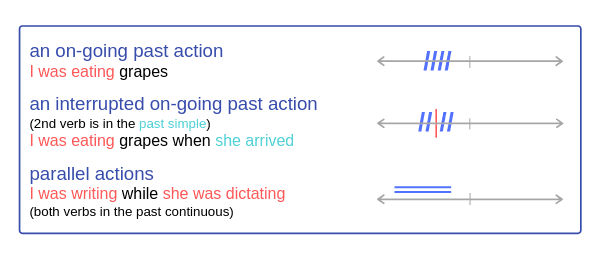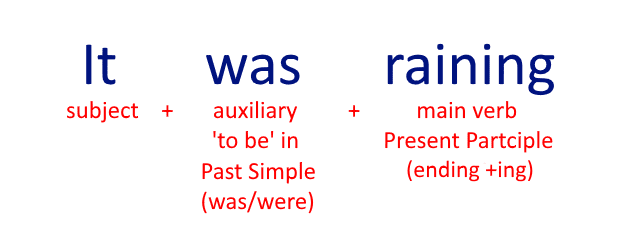Past Continuous
timeline, form, uses

The Past Continuous tense is used to express that an action was on-going in the past and if it was interrupted by another action. It also expresses that two on-going situations were happening at the same time in the past. We’ll explore the Past Continuous timeline, form, uses and examples below.
It is also called the Past Progressive tense.
TO FORM THE PAST CONTINUOUS TENSE
The Past Continuous form is made using:
– auxiliary verb ‘to be’ in the Past Simple (was / were)
– main verb in the Present Participle (ending +ing)

Past Continuous forms:
affirmative: subject + auxiliary + main verb
negative: subject + auxiliary + not + main verb
question: auxiliary + subject + main verb
negative question: auxiliary + subject + not + main verb
Past Continuous form for to write
affirmative
I was writing
you were writing
he/she/it was writing
we were writing
you were writing
they were writing
negative
I was not writing
you were not writing
he/she/it was not writing
we were not writing
you were not writing
they were not writing
questions
was I writing?
were you writing?
was he/she/it writing?
were we writing?
were you writing?
were they writing
negative questions
was I not writing?
were you not writing?
was he/she/it not writing?
were we not writing ?
were you not writing?
were you not writing ?
PAST CONTINUOUS USES
to show that an action in the past that was on-going was interrupted
She was sunbathing when it started to rain.
We were standing under Big Ben when it began to chime.
to express an action was going on at a particular time in the past
I was washing my hair at 10 p.m. last night.
Were you doing your exercises at seven o’clock this morning?
to express that two (or more) on-going situations were happening at the same time
I was not concentrating when he was giving me directions, so I got lost.
They were discussing their house extension and were drawing out plans.
CONTRACTED AUXILIARY VERBS
The Past Continuous uses the verb to be in the Past Simple as an auxiliary verb.
Auxiliary verbs are often contracted, especially in spoken and informal written language.
The contracted forms are:
| subject | negative | contracted |
| I, he, she, it | was not | wasn’t |
| you, we, they | were not | weren’t |
He wasn’t eating his lunch.
We weren’t taking the exam.
Weren’t you going shopping?
More on contracted auxiliary verbs
Past Continuous timeline, form, uses